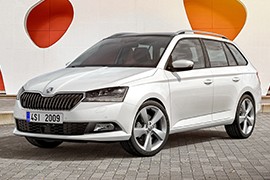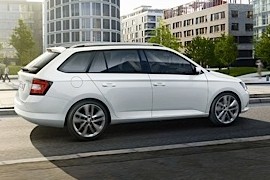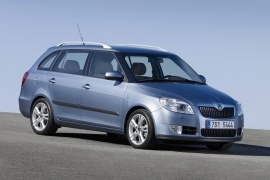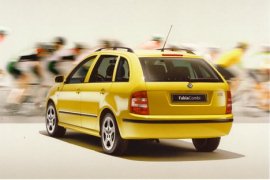SKODA Fabia Combi Models/Series Timeline, Specifications & Photos
First production year: 2000
Engines: Gasoline, Diesel
Body style: Hatchback
Skoda was one of the few competitors in Europe that offered a station wagon for its small-class segment comptitor, the Fabia, and in 2018 it introduced a facelift for it.
Volkswagen was keen to dominate the small-class segment station-wagons in Europe, and its main competitors were the Renault Clio Estate and the cheaper Dacia Logan MCV. Yet, the Czech brand Skoda pulled another version of its renowned Fabia Combi. The car was based on the same PQ26 platform shared with the Audi A1, the SEAT Ibiza, and the Volkswagen Polo.
Skoda's designers followed the same lines for the Combi as for its regular hatchback, although there were some differences from its profile. Behind the rear doors, the carmaker added an extended quarter panel and a set of side windows next to the trunk area. Finally, at the back, the raked-forward tailgate incorporated a windscreen wiper and a small roof spoiler on top.
Inside, the cubist exterior was replaced by a minimalist trend, especially on the base trim levels. But the options list was long, and depending on the trim level, the car could have been fitted with an infotainment unit and a 6.5" display on the center stack. The Fabia Combi was renowned for its trunk space, and this version didn't disappoint its customers with its 330 liters (11.6 cu-ft) of space, which could have been extended up to 1,150 liters (40.6 cu-ft) by folding down the rear bench.
Under the hood, there was only one engine available but offered with or without a turbocharger. The standard transmission was a 5-speed manual for the versions under 100 hp and a 6-speed manual for the 110 hp version. A 7-speed DSG (dual-clutch) automatic transmission was offered for the latter.
The third generation of the Skoda Fabia Combi (station-wagon) was released just a few weeks after the Skoda Fabia hatchback. The small, Czech, station-wagon was the most popular car in its segment.
The Czech car-maker delivered more than 1.1 million units of Skoda Fabia Combi to its customers between September 2000 and August 31st, 2014. The small-class vehicle offered 425 liters (15 cu-ft) for the first generation and it was increased up to 530 liters (18.7 cu-ft) for the third generation. It was far more superior to most of the cars in the compact class. Its spacious trunk-space and the small-segment price range made it a real deal for those working in sales departments. Moreover, it was fitted with a wide range of engines, including few fuel-efficient diesel versions.
The third generation of the Fabia featured a very angular design, with sharp lines over the headlights, side panels, and in the rear to the tailgate and taillights. The 2014 Fabia Combi was longer by 10 mm (0.4”), wider by 90 mm (3.5”), and 31 mm (1.2”) lower than its predecessor. The front grille featured the same vertical slats design as the rest of the Skoda range.
Inside, there was room for five adults, but with limited legroom for the rear occupants since the wheelbase was only 2.47 m (97.2”). The car could have been equipped with an infotainment system that allowed Apple CarPlay and Android Auto connectivity.
For the engine bay, the 2014 Fabia Combi was offered with a choice of diesel and gasoline engines, ranging from 75 hp up to 110 hp mated to either manual or DSG (dual-clutch) automatic gearboxes.
In the middle of the world financial crisis, Skoda had to refresh the Fabia lineup and kept its engine running while other big brands were collapsing.
Even though it wasn't the best time to invest in upgrades, the Czech carmaker had to refresh the Fabia lineup and bring it up to Euro 5 emission standards, which were due to enter in January 2009. The station-wagon version, named combi, offered a right balance between the car length, the trunk space, and the overall price. It was a smart choice for young families.
The facelifted model featured new headlights with a swept-back design. For the upper trim levels, they featured standard xenon headlights. Its new grille design with vertical slats and a chromed bar on top sported the green Skoda badge. Skoda installed extended rear quarter panels for the station-wagon version than those from the hatchback and mounted a roof-spoiler on top of the liftgate.
Inside, the carmaker changed the dials' design with new lettering, and the center stack featured a new sound system. Like the non-facelifted version, the Fabia Combi featured two seats at the front and a split-folding bench in the back. The users could have expanded the trunk size from a decent 480 liters (16.9 cu-ft) to 1226 liters (43.3 cu-ft). That was more than most hatchbacks could offer.
Skoda changed the older 1.4 and 1.6-liter engines under the hood with a new, 1.2-liter turbocharged unit developed to comply with the Euro 5 emission standards. Skoda also replaced the older 6-speed automatic gearbox supplied by Aisin with a new 7-speed automatic (dual-clutch) gearbox from Volkswagen Group.
Skoda introduced the Fabia in 1999 at the Frankfurt Motor Show. It shared its platform with the Seat Ibiza and the Volkswagen Polo Mk IV. In the following year, the Czech carmaker introduced the station-wagon version.
Skoda Fabia Combi was the little car with a compact-segment attitude. Combi was the name used by most East European countries for the station-wagon body-shapes, and the Czech brand used it on the Feliceia lineup, before Volkswagen Group purchased it.
Fabia's design was in the Czech-cubism style, with angular forms, including the headlights and the grille. With its arched roofline, the rest of the car was modern and dictated by the new design trends in the automotive industry. Unlike the Seat Ibiza Vario (station-wagon), the Fabia Combi featured an arched tailgate.
Inside, the car featured the same curved dashboard as the Fabia hatchback. The only rectangular elements on board were the air vents. A simple to read and understand instrument cluster featured distinct dials for the speedometer and tachometer and top-mounted gauges for the fuel level and coolant temperature. At the front, the seats were simple, with a few adjustments. The carmaker installed a split-folding bench in the back, which could expand the trunk from its standard 530 liters (18.7 cu-ft) to 1395 liters (49.2 cu-ft).
Under the hood, Skoda installed a choice of four gasoline and five diesel engines. All of them were paired to a 5-speed gearbox.



